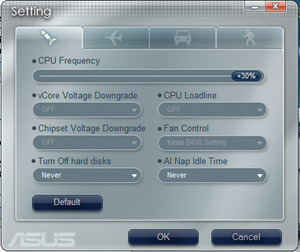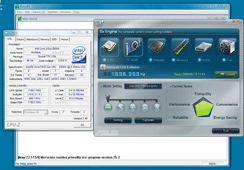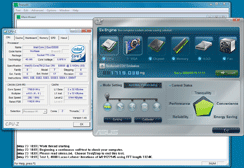Asus EPU 6-Engine
Asus EPU has been given an overhaul and a steroid injection – it now accommodates six areas of the motherboard, as well as being more inherently customisable. After calibration, the CPU, memory, chipset, hard drive, fans and graphics card can be handled and tweaked for power states and speeds. The only limitation we found was that the graphics needs to be an Asus board in order to have the proper interaction.The customisable nature of the EPU manages the main four power and performance states – turbo rocket, high performance flying, car driving and masculine strutting. These can each be customised according to their CPU frequency over/underclock, voltage downgrading and loadline (how the board handles vDroop), as well as fan control and the ability to turn off the hard drives or put the system completely to sleep once it idles.
It's really very easy to use for novices wanting to add a little customisation to overclock for more performance, and underclock or go to sleep entirely once it's been left idle can offer greater potential efficiency gains. For example: you're gaming so 15 percent extra CPU speed and turning fans up full keeps things cool; however, once you're done you've left a download running which uses minimal CPU usage and power, but still requires the system to stay awake and the hard drives active – just disable the "AI Nap" and "Turn off Hard Disk" options, but keep the CPU underclocked to a hefty 50 percent (providing the system takes a liking to it…). It's not entirely intuitive though – as simple as it's kept, it could use additional explanations because I don't know how many non-technical users understand what "Loadline Calibration" means, and whether "light" or "heavy" is a good thing.


What we did notice though was that CPUs—especially the quad cores—are very sensitive to the drop in core voltage, even if you drop the frequency accordingly the system will still lock up sometimes on the ambiguous "medium" and quite often on "heavy" settings. For example, out of two Core 2 Quad Q9550 CPUs, we found only one would be happy throwing it down to -50 percent at medium vCore drop.
The software still needs work in our opinion because as we played with the settings, every time the system locked up we had to completely remove the 6-engine software and reinstall it otherwise the calibration would crash the system, requiring a hard-reboot.
More advanced users will be still left wanting even more customisation too – we quickly ran into the need for more options. Don't get us wrong; keeping the first look simple is essential not to alienate more basic users, but a button that allowed more advanced options would be fantastic. We're missing things like CPU voltage increase for overclocking; memory speed and voltage increase/decrease; feature enable/disable (like unused USB, Firewire or Ethernet); north bridge and memory phase use (MSI now offers this); and very importantly: load sensitivity.
We found that while wanting to leave the CPU idle and very underclocked for the most part, doing things like listening to music and surfing the net still didn't elevate the CPU load up a notch to make it a little more snappier – we had to literally either sit between really hammering the CPU or barely using it. What Asus has done is improved the response rate for increasing the clock speed – if you suddenly do something very intensive the clock speed upscaling reacts a lot faster than it has done previously.
Power Consumption
Between idle and load the EPU switches between a lowly four phases and the full sixteen, yet nothing in between. Asus told us that the power saving between eight and sixteen wasn't that great and the power spread over sixteen meant that everything just ran a bit cooler. In addition, Asus also claimed that because the phase change was far less often (than Gigabyte’s DES system), the CPU was less prone to power spikes.It's incredibly difficult to check the effect of power spikes and its effect on hardware, stability and component life unfortunately, but we can investigate power efficiency at the wall.
What does make us question Asus's claim is the fact that we've never even seen Gigabyte's twelve phase DES system ever use the full twelve phases – even with a highly clocked quad core CPU it's only ever found the need to sit between six and ten, so why do we now need a sixteen phase setup from pretty much the same hardware. Where does the efficiency curve lie for the low RDS(on) MOSFETs? Do they work better at low-medium loads rather than always "all out" like on Gigabyte boards with DES?
We used a specific GeForce 9800 GTX, pair of OCZ FlexXLC PC2-9200 memory and Intel Core 2 Quad Q9550 CPU in both systems, as well as identical 750W PC Power and Cooling PSUs and 250GB Seagate 7200.9 SATA hard drives to keep everything as exact as possible.
The first thing to note is that we can't compare the boards directly – the Gigabyte is using a higher power X48 chipset and the Asus has its ExpressGate SSD. We're yet to still discuss Gigabyte's new "DES Advanced" software with the company’s representatives, having received it just before this review was published we've not yet had time to play with it in depth.
With the clock option set to its minimum value of just one percent on the Asus 6-engine software (you can't disable it completely) to match Gigabyte's DES software in only adjusting CPU phase use, we can see that the Gigabyte drops 11 watts under load and two watts when idle between its DES being on and off. In contrast the Asus drops nine watts under load and a much larger eight watts at idle. That's the difference between Gigabyte's virtual 12 phase and Asus 16 phase CPU because, while both sit at four phases use when idle, it's understandable that Asus is better off because it drops that much more. Both seem to benefit greatly from their power saving software – this is despite Asus only flicking between four and the full 16 phases, and Gigabyte providing a much finer, continual adjustment to CPU power phase use – normally it'll sit between six and eight phases under load.
Asus uses this free load overhead to overclock the CPU – the stock settings are to overclock the CPU by five percent, and underclock it by 10 percent with a "medium" vCore drop. Asus only manages to offer a single watt extra saving from that 10 percent underclock, however it also uses six watts more by overclocking the CPU when loaded. However that six watts is still lower than when not using the 6-engine EPU and since it's overclocking your CPU, it gets your work done quicker so the overall efficiency over time is still higher.
What does limit Asus's software is that you can't adjust ANY of the BIOS timings if you want to use this – we tweaked the memory settings and didn't overclock the CPU, but found that the software then refused to work. Comparatively, since the Gigabyte software works on the foundation of power phase changes only, it doesn't mind if you overclock and tweak the CPU, but it doesn't actively change the front side bus like Asus's EPU does, nor does it simultaneously overclock and underclock – what it calls "CPU Throttling" is just Intel's native EIST and C1E states taking effect.
Effectively, while both companies are doing their own thing, neither has the right answer it seems, we're literally weighing up six of one and half a dozen of the other.

MSI MPG Velox 100R Chassis Review
October 14 2021 | 15:04












Want to comment? Please log in.